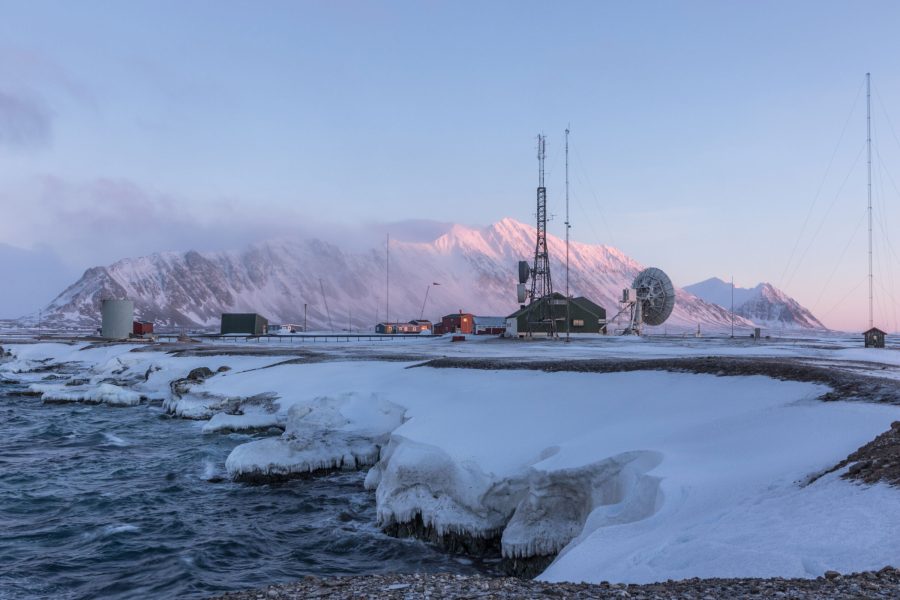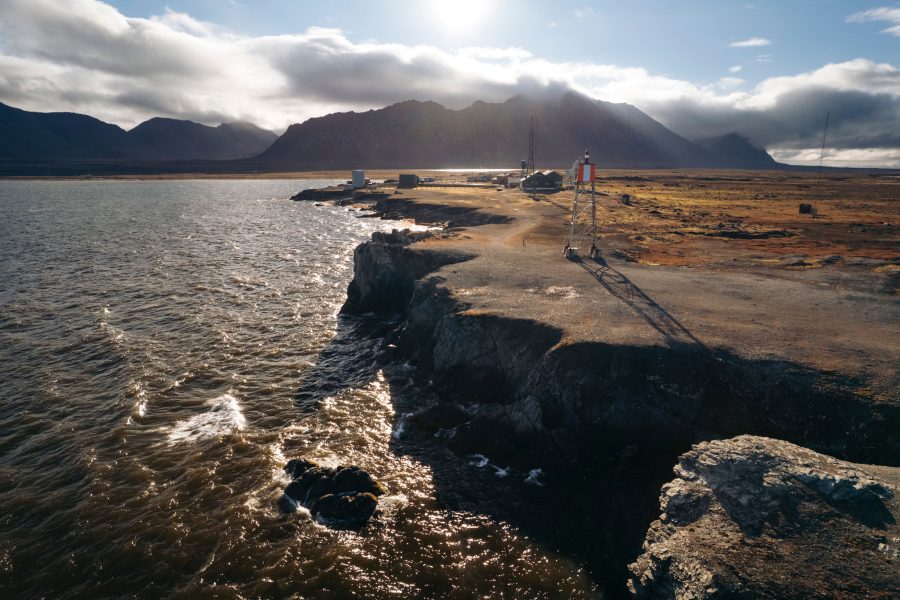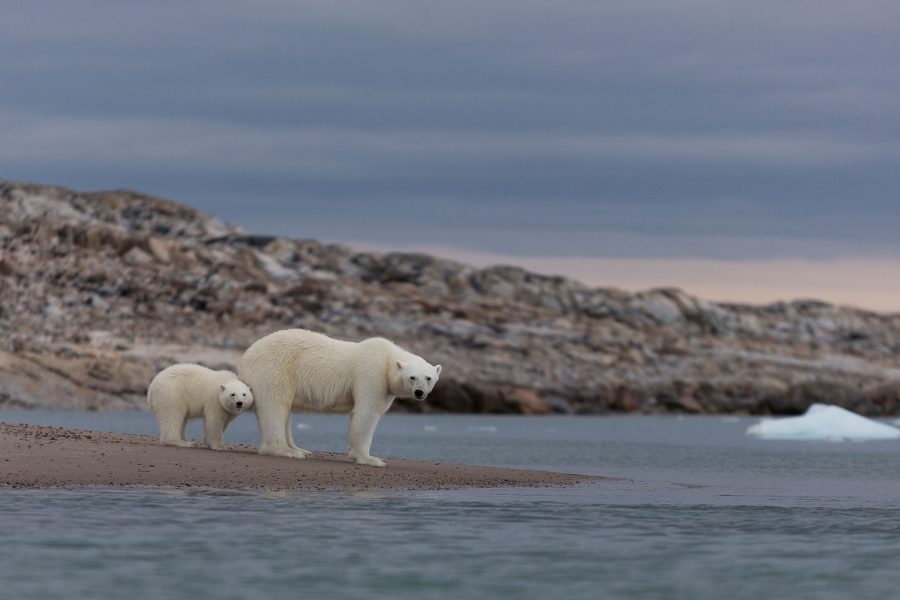Story at a glance:
- Isfjord Radio is a remote Norwegian outpost with a mission to achieve clean energy and be an example for other vulnerable climates.
- A solar project at Isfjord Radio has reduced overall diesel consumption by approximately 70%.
- The property is also home to an adventure hotel for Arctic explorers, part of an evolving effort of sustainable tourism on Svalbard.
ˮPlease note that Isfjord Radio is a wilderness hotel and to move outside you need a guide with rifle for polar bear protection.”
Wait, what?
I clearly hadn’t thought this through. I hadn’t even considered polar bears when I booked the flight. Now I was on a boat from Longyearbyen, the main settlement on Svalbard in the Arctic, to a remote lodge 55 miles away, crossing the fjord to learn about a historic property’s sustainability efforts and, well, maybe see a polar bear? Two were spotted near the property earlier that week.
I asked for the address so I could tell my loved ones where I’d be. “There is no address,” I was told. “It’s the wilderness.” OK then. Let’s go.
The Journey

Isfjord Radio Adventure Hotel offers guided excursions in a remote area on Svalbard. Photo by Ramon Lucas
First we met at Basecamp Hotel in Longyearbyen. The modern-day take on a trapper’s lodge is decked out in driftwood and sealskin with maps and photos of adventure at every turn. I sipped tea and waited for the van to pick us up and take us to the 12-passenger boat.
It ended up being a surprisingly calm day out on the water. It was so calm my seatmate was knitting a sweater on the ride.
The roughly two-hour journey took us past old mining towns, including Grumont—a former Soviet company town established in 1912 and abandoned in 1965. So many Arctic terns and puffins passed by that I lost count.
Arriving at Isfjord Radio

Isfjord Radio is only reachable by boat in summer or dog sled or snowmobile in winter. Photo courtesy of Basecamp Explorer

An estimated 3,500 polar bears live on Svalbard—exceeding the human population. Photo by Sophie Cordon, Visit Svalbard
They weren’t joking about the rifles. As soon as we stepped off the boat, smiling guides with weapons casually slung over their shoulders were waiting to give us the rundown and a quick tour once settled. Fortunately we never got too close to any polar bears (we did see one through binoculars on the beach), but reindeer we saw everywhere.
Initially a radio station, the property opened in 1933 as a crucial connection from Svalbard to the outside world. The station was destroyed by both sides during World War II and rebuilt in 1946 (you can still see craters from the war onsite). The central buildings at Isfjord Radio were built in the 1950s, with additional structures added later.
Today Basecamp Explorer runs the Isfjord Radio Adventure Hotel. While it may look rustic from the outside, inside has all the comforts of any modern hotel, including a warm dinner with optional wine pairings. Just steps from the hotel, a sauna overlooking the water is an added bonus—guests just have to remember to take a guide carrying a rifle with them when they go.
Sustainable Strategies

Isfjord Radio has been adapted to offer modern lodging in a remote setting. Photo courtesy of Basecamp Explorer
Today the property is also home to a pilot program for renewable energy. The solar project was completed in early September 2024 and produced energy through late October.
“Many remote Arctic communities are looking into how to reduce their diesel consumption, and the learnings from this project could be valuable for those communities,” says Mons Ole Sellevold, project manager for the energy project. He’s been involved since phase one construction began in May 2021. The pilot project aims to be replicable for other remote communities dependent on fossil fuel.
From the end of October to the middle of February Svalbard experiences total darkness, when little energy can be obtained from the system. But when the midnight sun shines 24 hours a day from April to August, an extensive battery pack in the basement at Isfjord Radio can be fully charged for later use.
“From the two solar facilities at Isfjord Radio—the ground-mounted and the rooftop-mounted—we expect to produce about 230,000 kWh in a normal year, accounting for about 40% of the total annual energy needs at Isfjord Radio of 575,000 kWh,” Sellevold says.
The project at Isfjord Radio has reduced overall diesel consumption by approximately 70%.
“We are very happy about this, but there is potential to reduce it even further by introducing more renewable energy production,” Sellevold says. “We are looking into wind power to be able to also deliver renewable energy production during the polar night and the winter months.”
The learnings from this project could be valuable for those communities.
Norwegian mining company Store Norske owns the facility at Isfjord Radio and started looking into alternatives early on. The exploration into wind is being carefully considered given that a bird sanctuary sits next to the station.
“We have been looking into a project, including installing two smaller wind turbines of about 25 kW each,” Sellevold says. “They are about 18 meters (59 feet) tall. We think this turbine size would be suitable for the local conditions and energy needs at Isfjord Radio and also more bird-friendly than larger wind turbines.”
Currently during polar nights the property runs largely on its existing diesel generators. Sellevold says going for 100% diesel reduction would likely be difficult and may result in over-investment in renewable production capacity, but the team would be very pleased to achieve 90% diesel reduction. “Diesel generators will most likely be needed as a backup and peak load capacity for a long time anyway. It’s all just about using it as little as possible,” he says.
Sellevold says he’s most excited about the opportunity to combine different types of energy technologies across production, storage, and consumption—making them all work together to reduce diesel consumption.
The project is working toward using 90% renewable energy in 2025. The battery pack and thermal storage also includes 12,000 liters of hot water.
While Isfjord Radio attracts visitors from all over for everything from midnight sun to wilderness hikes to see walruses, it’s also a popular spot for students and researchers studying meteorology, glaciology, wildlife, and more.
“It is a unique pilot project for Arctic hybrid energy systems, and it’s under continuous development and improvements,” Sellevold says. “There is a lot that needs to be developed and learned along the way, and we are happy to cooperate and share our findings with other actors and with research and education institutions.”




